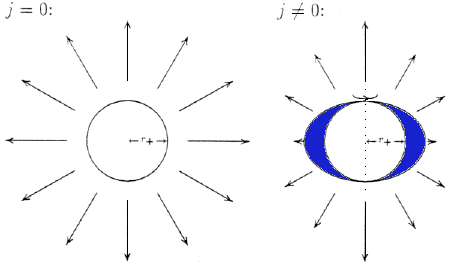|
Publications
|
Relativistic rotational darkening of lightlike radiation and von Zeipel's theorem for radially emitting spheriods
Andreas de Vries and Theodor Schmidt-Kaler, published in: Astrophysics and Space Sciences 266, 371-378 (1999), doi:10.1023/A:1002072030775
A new relativistic effect of rotation on lightlike radiation, the rotational darkening, is discovered. It is observable for relativistically rotating astronomical objects.
It is shown mathematically that an outgoing null radiation field (e.g., light) in the outer space of a black hole is darkened by the hole's rotation. This rotational darkening is calculated for a spheroid emitting null radiation normally (“perpendicularly”) to its surface. The radiation shows a “von Zeipel” effect that the equatorial region is darkened more strongly than the polar regions, cf. Fig. 1.

Fig. 1: Rotational darkening of lightlike radiation. Left there is the intensity of a radiation field as measured by a distant observer in case of a non-rotating black hole with angular parameter j = 0 (a static “Schwarzschild” or, in case of electrical charge, a “Reissner-Nordström” black hole); the intensity is assumed to be normally emitted and uniform on the surface. Right is the same scenario, but with a rotating black hole (a “Kerr-Newman” black hole). The radius r+ denotes the event horizon, the “edge” or “membrane” of the black hole, the blue region assigns the “ergosphere”.
This effect is not confined to the case of black holes but is also observable for relativistically rotating fluid spheroids such as atmospheres of pulsars or neutron stars, as well as luminant gas balls such as galaxy cores, remnants of supernovae, or nebulae around a central light source.